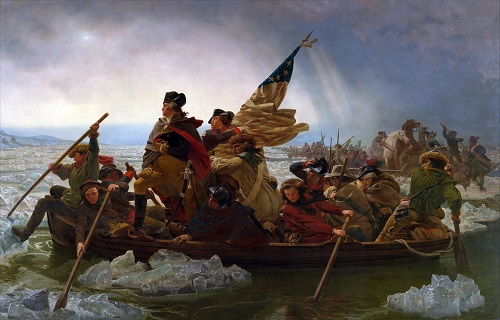
On this day 241 years ago – December 26, 1776 – George Washington led his forces to a much-needed victory in the Battle of Trenton. Crossing the icy waters of the Delaware River on Christmas night to achieve maximum surprise, his decisive defeat of the Hessians encamped in New Jersey bolstered the colonies’ faltering faith in his military leadership. That led to the foundation of our constitutional republic, enlivened by virtue flowing from religious faith. To this day in much of the world, Washington symbolizes the perfect mean of liberty and personal responsibility within the Western Judeo-Christian framework.
Washington’s words and example have inspired generations of people in centeral Europe to strive after that high degree of liberty, writes Hungarian political scientist Márk Németh in a new essay at Acton’s Religion & Liberty Transatlantic website.
With the brewing controversy over historic monumnts in the U.S., “it may surprise Americans to know that a statue of Washington stands proudly in the heart of Budapest,” writes Németh.
The story of how and why Hungarians erected a statue of George Washington in City Park in 1906 in a fascinating one, which Németh captures well. After a group of Hungarian-Americans built a statute of a great Hungarian politician in Cleveland, they suggested that Hungary make a reciprocal gesture to bring the two nations closer together.
In 1904, Count Albert Apponyi – a leading political figure, who befriended U.S. presidents Theodore Roosevelt and William Taft – said that the American ideal of liberty served as a beacon across the other side of the Atlantic, a century after Washington’s death. Németh writes:
“We have hearty sympathy with this gigantic commonwealth, which has achieved liberty for all time, a liberty which makes us in Europe feel safer,” he said, adding that the good example gladded even “lands where liberty is scarcely known.”
“We feel safer because there is such a country as the United States of America,” Apponyi said. “The freedom of America is one of the safeguards of liberty in old Europe.”
These words are confirmation that, more than a century ago, the United States had fulfilled the Puritans’ vision to become “a shining city on a hill,” an example of Christian liberty for all nations (especially those in the lands they had left. Or it is confirmation that Washington had succeeded in a task he summarized in these words: “Let us raise a standard to which the wise and honest can repair. The event is in the hand of God.”
Washington, Németh notes, has become a source of controversy in the United States, as religious leaders have demanded his statues be demolished, his name erased from public spaces founded in his honor. This fall, Washington’s own parish – Christ Church, a liberal Episcopal congregation in Alexandria, Virginia – removed a plaque commemorating its most significant member.
But distinctions and intent are important, Németh writes. These monuments commemorate Washington, not as a slave owner, but as a liberator whose political philosophy would one day demand that slaves be given equal dignity and freedom. Washington’s sacrificial affirmation of unalienable rights and self-determination continues to inspire those who do not currently enjoy the liberties he was willing to die for, across the transatlantic sphere.
Márk Németh, a Millennial, does not shy away from his own conflicted views about Washington, the freedom fighter who owned slaves. He shares his struggles with honoring even someone as great as Washington, due to this grave injustice. But he reveals the two quotations of Washington’s that most inspire him (which you can read here), before concluding:
As a Hungarian political scientist living in a country that still does not enjoy all the liberties of the United States of America, I think George Washington should not be evaluatd based on the pastor’s criteria, but by these two quotations. They continue to inspire the best in all mankind – across oceans, across cultures, across eras.
Read his full article (and see photos of the statue) at Religion & Liberty Transatlantic.
(Main photo credit: Public domain.)

